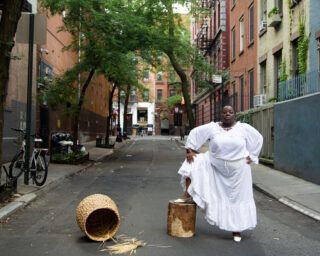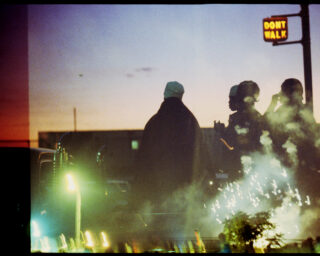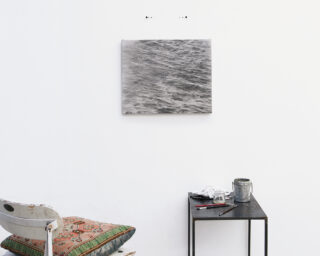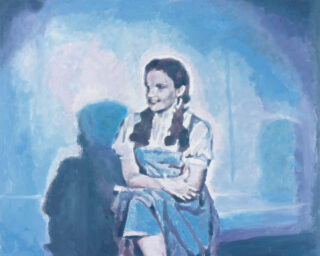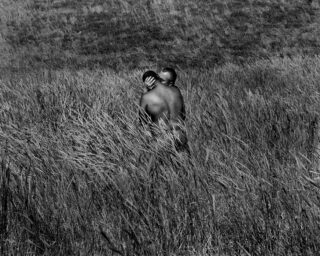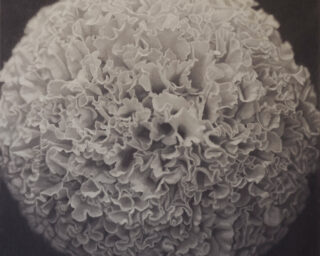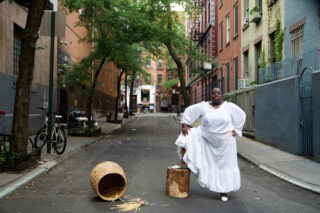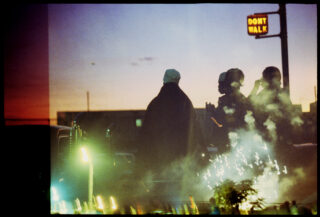Prajna Desai: "Constructing Worlds" at Barbican Art Gallery
The 18 photographers in “Constructing Worlds” collectively represent how “photography which takes architecture as its subject matter has the ability to communicate wider truths about society,” according to the show’s curatorial statement. The exhibition is organized across two levels of linked solo displays, each contributing to a chronology that begins in the 1930s and ends in 2012. The format makes for luxurious, immersive viewing. Navigating a sequence of independent displays that propel one through time gives the sense of having travelled smoothly through history, ending up in the present day looking into the future.
The show aptly begins with Berenice Abbott and Walker Evans. Although both were attracted to architecture, Evans ultimately forged a new photographic approach to architecture’s relationship with its surroundings and the people that inhabit it. He focused on the design and composition of building facades in small towns tucked away in the American Deep South still reeling from the Depression-era economy. The profusion of detail in his tight, frontal shots of timber churches, gas stations, storefronts, and frame houses in which buildings and figures stand in stark contrast to one another are all captured with deadpan candour. Ironically, Evans’ intentionally blunt commentary, which happened to make various types of buildings a primary expressive device, ended up excoriating the effects of modern society in vernacular America. Its new products, insistence on variety, and false sense of abundance had made of life something cruel, unfair, and without charm, his photographs seem to say.
The following displays verify this view of photography as more than a document. Julius Schulman’s postwar color photographs– advertisements for a new variety of residential buildings designed by Richard Neutra, Charles and Ray Eames, and Pierre Koenig in California– revisit a central lesson from Evans. These intimate, transparent images of the buildings draw attention away from the artist’s sensibilities to the subject of architecture as an agent of social change and cultural identity. Elsewhere, Lucien Hervé exposes the meta qualities of Le Corbusier’s architecture, and both Stephen Shore’s and Thomas Struth’s concentrate on ordinary architecture including nondescript streets: all appear as witting or unwitting heirs to Evans’s work. However, they somehow seem to lack Evans’s empathy with the human protagonist. People in this work appear either rarely or not at all.
Up through Struth, this narrative of photography’s relationship with architecture proceeds so seamlessly that the show’s second half feels bewilderingly confused. Suddenly, in the midst of highly formalist work by Hélène Binet, Hiroshi Sugimoto, and Luisa Lambri, we confront photographs of hot zones: sites of titanic economic power, new post-revolution cities, post post-colonial cities, and post-apocalyptic war zones. These types of scenes are present in work by four of the most dramatic photographers featured in this section, namely Simon Norfolk, Nadav Kander, Iwan Baan, and Bas Princen. In tone and subject, their work serves to dramatize the show by its overtly political stance, and rightly so.
In Simon Norfolk’s Former Soviet-era ‘Palace of Culture’, Kabul, 2001-2002, for example, bombed out structures in Kabul are bathed in golden light. In Nadav Kander’s Chongqing XI, Chongking Municipality, 2007, and Fengjia III (Monument to Progress and Prosperity), Chongking Municipality, 2007, an incomplete bridge and a lone building that resembles a defunct Transformer respectively serve to frame industrialized China, as if positing the evolution of a somewhat eerie if sublime new landscape. Elsewhere, Iwan Baan’s images of squatters in an aborted and abandoned commercial complex in downtown Caracas attempt to record how ordinary people, originally evicted from their own homes, used the aftereffects of the 1994 Venezuelan banking crisis to their advantage. Torre David façade, 2011 and Small businesses like this can be found throughout the building, 2011, offer a sampling of the condition Baan’s images reveal.
When juxtaposed with the curatorial premise, this body of work seems less related with architecture and architect per se than with existing political or social conditions: the structures depicted seem to be more of products than agents. In Hervé’s photographs of Corbusier’s buildings, for example, people ambling across a building look like quirks in an otherwise abstracted geometry. On the other hand, the upscale residents in Schulman’s pictures of designer homes are as integral to the architectural design and its social value as actors are to a theatrical stage set.
But in Kander, Baan, and, to a lesser degree, in the work of Princen, context is everything. For this reason, including these photographers, despite their sophistication, feels like a compulsion to “color” the exhibition with a somewhat forced global history. Unlike say, Sugimoto, Lambri, or Binet, and their rather modish fascination with architectural form and its aura, this newer work is fueled by the desire to tell a story about the future world fallen into ruin even while it’s being constructed.
Their inclusion also cleaves the exhibition along undeniably racial lines. The new cities of world are not filled with the typically crass but shiny building projects that mainstream media represents of developments in Dubai or Cairo. Rather, in this show, these cities appear populated by the wreckages or ghosts of an architectural imagination that is variously arrogant, jerry-built, and gone awry in every instance, possibly because it lacks the traditional impetus of Western architectural thinking, its goals, and its dazzling names. This is the conclusion to draw if one believes that the subject of the photographs by Norfolk, Kander, Baan, and Princen, is in fact buildings and architecture, rather than a picture of a world gone mad.










